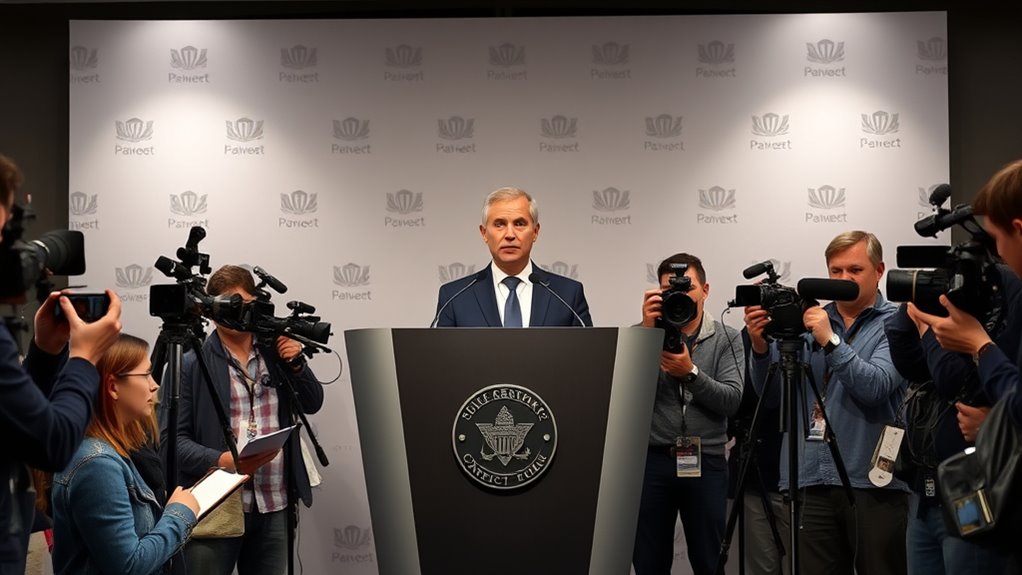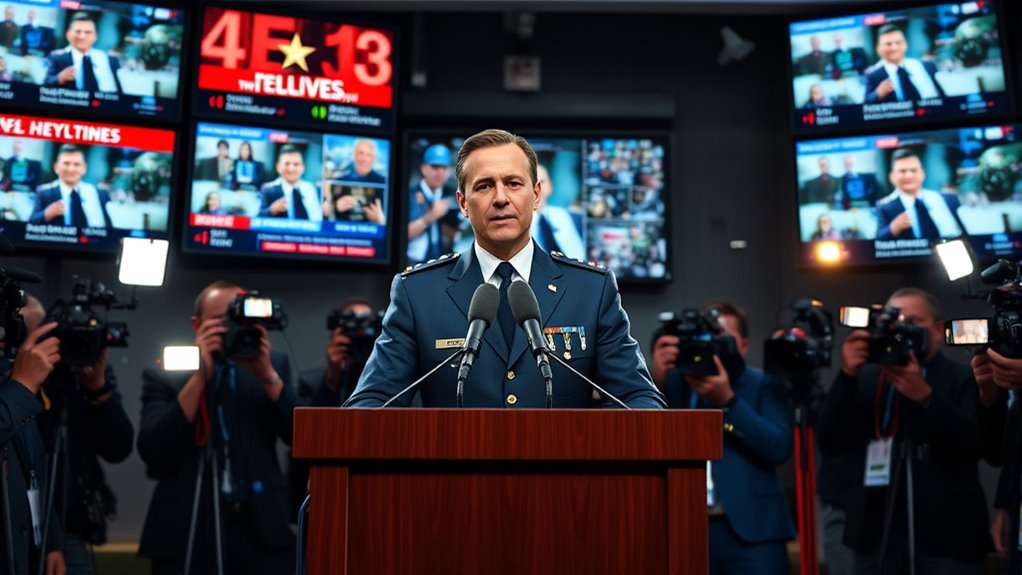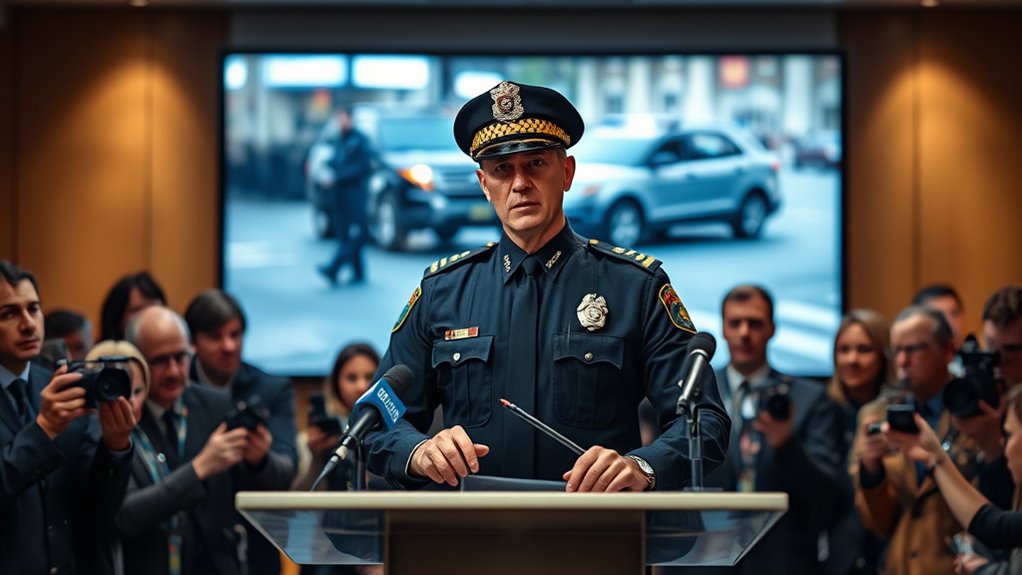When handling media requests after a major case, you should establish a clear communication plan with key messages and designate credible spokespeople trained to stay calm and consistent. Control sensitive information by sharing only approved facts and setting boundaries on what can be disclosed. Monitor media coverage and public reactions, and respond promptly to misinformation with transparency. Following a structured approach builds trust—learning more about effective strategies can help you manage future situations smoothly.
Key Takeaways
- Designate a single, trained spokesperson to handle all media inquiries for consistent messaging.
- Prepare clear, factual key messages and verify information before sharing to prevent misinformation.
- Establish protocols to restrict sensitive details, ensuring privacy, investigation integrity, and legal compliance.
- Respond promptly within set deadlines, and organize regular media updates to maintain transparency.
- Document all communications and monitor media coverage to address false information and assess public perception.
Establishing a Clear Media Communication Strategy

To effectively manage media requests, you need a clear media communication strategy in place. Start by defining your key messages—what you want the media and public to understand about the case. Identify your goals: whether to inform, reassure, or clarify misinformation. Establish protocols for responding to inquiries promptly and consistently, ensuring everyone involved knows their roles. Decide on preferred channels of communication, such as press releases or social media updates, and coordinate timing to maintain message accuracy. Remember, your strategy should also include guidelines for handling sensitive information and potential crises. Having a well-structured plan ensures your messaging remains controlled, transparent, and aligned with your organization’s objectives during this critical time. Incorporating crisis communication techniques can further enhance your preparedness and effectiveness in managing media interactions.
Designating Spokespersons and Training Them Effectively

Once you have your media communication strategy in place, the next step is to identify who will serve as your official spokespersons. Choose individuals with credibility, calmness, and strong communication skills. They should be knowledgeable about the case, able to handle tough questions, and stay on message. Provide thorough training to prepare them for media interactions. This includes practicing clear, concise responses and understanding the importance of maintaining a consistent tone. Make sure they are familiar with the overall strategy and key messages, even if you’re not discussing specific details yet. Regularly update and coach your spokespersons as new developments arise. Well-prepared spokespersons ensure your message remains controlled, credible, and transparent during intense media scrutiny. Incorporating best anime movies into training scenarios can help them improve their storytelling and emotional intelligence skills, which are crucial during high-pressure interviews.
Developing Key Messaging and Talking Points

To effectively handle media requests, you need to clarify your case details and make certain your messaging is clear. Emphasizing transparency principles helps build trust and credibility with your audience. Preparing concise, impactful key messages keeps your responses focused and consistent. Additionally, understanding crypto pump trends can help you address inquiries about market fluctuations accurately.
Clarify Case Details
How can you guarantee your messaging clearly communicates the key details of the case? Start by distilling complex information into straightforward points. Focus on facts, avoid speculation, and emphasize what’s confirmed. Use consistent language to prevent misunderstandings. To ensure clarity, prepare a table that highlights essential elements:
| Aspect | Details |
|---|---|
| Case Overview | Brief, factual summary |
| Key Facts | Confirmed details, dates |
| Disputed Points | What’s unresolved |
| Legal Status | Pending, resolved, ongoing |
| Contact Info | Who to reach for updates |
This helps keep messaging accurate, transparent, and easy to understand, providing a clear framework for media interactions. Additionally, ensuring all communications are aligned with verified information from KTM Electric Dirt Bikes and related sources is crucial for maintaining credibility.
Emphasize Transparency Principles
Building on the importance of clear case details, emphasizing transparency principles is essential when developing your key messaging and talking points. You want to be honest and open without revealing sensitive or unverified information. You focus on providing accurate facts that build trust and demonstrate your commitment to accountability. Clearly communicate what is known, what’s being done, and what remains under investigation. Avoid speculation or overpromising, as this can damage credibility. Your goal is to foster understanding and confidence by consistently aligning your messaging with the core values of honesty and openness. This approach reassures the public and media that your organization is handling the case responsibly, laying a foundation for constructive dialogue and future engagement. Incorporating emotional support strategies can also help manage public perception and provide reassurance during sensitive times.
Prepare Key Messages
What are the key messages you want to communicate to guarantee your message resonates clearly and effectively? You need to identify core points that address the audience’s concerns and reflect your organization’s stance. Focus on clarity and consistency, avoiding jargon or ambiguous language. Develop talking points that are straightforward, factual, and aligned with your overall strategy. Anticipate questions and craft responses that reinforce your key messages. Practice delivering these messages confidently to ensure they sound natural and credible. Remember, your goal is to build trust, demonstrate transparency, and control the narrative. Well-prepared messages help prevent misinterpretation and ensure your communication remains focused, professional, and impactful during media interactions. Additionally, understanding projector technology can help you explain technical aspects more effectively if relevant to your message.
Timing and Coordinating Media Interactions

To manage media interactions effectively, you need to set a clear response timeline to make certain of timely communication. Coordinating media briefings helps keep everyone on the same page and prevents conflicting messages. By organizing these elements, you can control the flow of information and maintain a confident media presence. Additionally, understanding the best practices for media relations ensures that your messaging remains consistent and professional during high-pressure situations.
Establish Response Timeline
Establishing a clear response timeline is crucial for coordinating media interactions effectively. It helps set expectations, guarantees consistent messaging, and prevents misinformation. To do this, consider these key steps:
- Determine immediate response deadlines to address breaking news.
- Schedule regular updates to keep media informed without overwhelming them.
- Allocate specific times for press briefings or interviews.
- Establish review periods to approve messaging before release.
Coordinate Media Briefings
Once you’ve set your response timelines, the next step is to coordinate the timing of media briefings and interactions. You want to ensure your message is clear, consistent, and delivered at the right moment. Schedule briefings strategically, considering the news cycle and public interest. Coordinate with your team to avoid overlapping messages or conflicting information. Prepare key spokespersons in advance, providing them with talking points and anticipated questions. Timing is vital—hold briefings when they can have the most impact, such as after major developments or evidence releases. Communicate internally to keep everyone aligned on the schedule. Be mindful of public perceptions and how timing can influence media coverage. By carefully planning your media interactions, you control the narrative and maintain credibility during a sensitive situation.
Managing Media Inquiries and Requests for Information

Managing media inquiries and requests for information requires a proactive and organized approach. You need to respond promptly, ensuring accuracy and consistency in your messaging. To do this effectively, consider these steps:
- Designate a single point of contact to handle all media requests, preventing confusion and conflicting information.
- Prepare key messages in advance, focusing on facts and avoiding speculation.
- Keep detailed records of inquiries and your responses for accountability and future reference.
- Set clear boundaries about what information can and cannot be shared, maintaining control over sensitive details.
- Incorporate information management strategies to ensure that responses are coordinated and aligned with your overall communication plan.
Handling Sensitive or Confidential Information

Handling media inquiries requires not only prompt and accurate responses but also careful management of sensitive or confidential information. You must protect details that could compromise ongoing investigations, violate privacy, or harm individuals involved. Always verify what information is permissible to share before responding. Keep a clear protocol: share only what’s approved, escalate questions when unsure, and document all communications. To visualize, consider this table:
| Information Type | Handling Approach | Example |
|---|---|---|
| Personal Identifiable Data | Limit disclosure, secure storage | Names, addresses |
| Investigation Details | Share only authorized updates | Case progress, evidence |
| Confidential Sources | Maintain confidentiality, avoid leaks | Informants, witnesses |
Monitoring Media Coverage and Public Response

Monitoring media coverage and public response is essential for maintaining your organization’s reputation and promptly addressing any emerging issues. Staying alert helps you identify how the story is being portrayed and gauge public sentiment. Regularly reviewing reports on Pimple Patch efficacy and safety can also help you anticipate concerns and provide accurate information. Here are four key actions to take:
Monitoring media and public response is vital for protecting your organization’s reputation and addressing emerging issues promptly.
- Track news outlets, social media, and blogs for mentions related to your organization.
- Analyze tone and sentiment to understand public perception.
- Identify trending topics or concerns that require your attention.
- Document coverage to assess the impact and inform your response strategy.
Responding to Misinformation and Rumors

Have you noticed false information spreading online or through social media? When you come across rumors or misinformation, address them promptly and clearly. Don’t ignore or dismiss false claims; instead, provide accurate facts backed by credible sources. Use your official channels to clarify misunderstandings and dispel myths. Maintain a calm and professional tone, avoiding aggressive language or personal attacks. Remember, your goal is to restore trust and prevent misinformation from gaining traction. If needed, correct misconceptions publicly and encourage media outlets to verify details before sharing. Staying transparent and consistent helps counteract false narratives and reassures the public that you’re committed to honesty. Responding swiftly and accurately is essential to maintaining your credibility and controlling the narrative.
Evaluating and Adjusting Media Strategies Post-Case

After a case concludes, it’s essential to evaluate your media strategy to identify what worked and what didn’t. This reflection helps refine your approach for future situations. Start by reviewing media coverage to see how your messages were received. Then, analyze your response timeline and stakeholder engagement. Consider feedback from your team and any public responses. Finally, identify areas for improvement and adjust your strategy accordingly. Here are four key steps:
- Review media coverage and tone
- Analyze response timing and effectiveness
- Gather internal and public feedback
- Develop a plan to improve messaging and response tactics
Frequently Asked Questions
How Can We Maintain Transparency Without Compromising Ongoing Investigations?
You can maintain transparency by sharing general information about the investigation process without revealing sensitive details. Keep the public informed through official channels, such as press releases or briefings, emphasizing your commitment to transparency. Be clear about what is confidential and why, and avoid speculation. This approach helps build trust while protecting the integrity of ongoing investigations, ensuring the public stays informed without compromising case details.
What Legal Considerations Should Be Taken Into Account During Media Interactions?
You should always be aware that legal considerations can make media interactions a minefield. Stick to facts, avoid speculation, and never disclose protected or confidential information. Remember, even a small slip-up can have enormous consequences, so consult with your legal team before speaking. Be cautious about promises or commitments, and guarantee your statements align with ongoing investigations to protect everyone’s rights and integrity.
How Do We Handle Media Requests From International Outlets?
When international outlets request information, you should coordinate with your legal team first. Provide clear, consistent messaging that aligns with your organization’s policies and legal advice. Designate a trained spokesperson to handle these requests and avoid sharing sensitive or unverified details. Always clarify what information can be released and remind media outlets of confidentiality and legal considerations. Respond promptly, professionally, and in a way that protects your organization’s reputation.
What Are Best Practices for Managing Social Media Inquiries?
You should respond promptly and professionally to social media inquiries, balancing transparency with caution. While quick replies show you’re engaged, avoid sharing sensitive details that could compromise the case. Use clear, consistent messaging and direct complex questions to official channels. Remember, social media moves fast—stay vigilant, monitor conversations actively, and maintain a respectful tone to safeguard your reputation and ensure accurate information dissemination.
How Should We Document and Archive Media Communications for Future Reference?
You should create a centralized system to document and archive all media communications. Save emails, social media messages, and transcripts promptly, and organize them by date and channel. Use consistent naming conventions and secure storage, like a digital database or cloud service. Regularly back up this archive to prevent data loss. This way, you’ll have a clear, accessible record for future reference, ensuring transparency and accountability.
Conclusion
After a major case, your media approach shapes public perception. For instance, during the XYZ case, clear messaging and trained spokespeople helped control the narrative. By promptly addressing inquiries and correcting rumors, you can build trust and maintain credibility. Remember, a well-planned media strategy not only manages current coverage but also sets the stage for future communication. Stay proactive, adaptable, and transparent to protect your organization’s reputation long-term.









